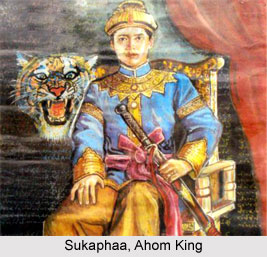 Sukaphaa, also known as Chaolung Sukaphaa was the founder of Ahom kingdom in medieval Assam. He was a Tai prince who belonged to Mong Mao which is presently a part of China. He established Ahom kingdom in the year 1228 which lasted for about 600 years and in course of time unified numerous tribal as well as non tribal people who influenced the kingdom in several ways. Legends of Ahom kingdom say that Sukaphaa was the descendant of God Khunlung, who had come to earth from heaven.
Sukaphaa, also known as Chaolung Sukaphaa was the founder of Ahom kingdom in medieval Assam. He was a Tai prince who belonged to Mong Mao which is presently a part of China. He established Ahom kingdom in the year 1228 which lasted for about 600 years and in course of time unified numerous tribal as well as non tribal people who influenced the kingdom in several ways. Legends of Ahom kingdom say that Sukaphaa was the descendant of God Khunlung, who had come to earth from heaven.
Early Life of Sukaphaa
Origin and life of Sukaphaa are recorded in different chronicles which unfold contradictory tales. As per Phukan, Chao Chang-Nyeu and Nang-Mong Blak-Kham-Sen were the parents of Sukaphaa. Chao Chang Nyeu, the prince of Mong-Ri Mong-Ram, had reached Mong Mao on expedition. At that time Chao Tai Pung ruled over Mong Mao and Chao Chang Nyeu became friends with the son of the ruler Pao Meo Pung and married his sister Blak Kham Sen. Sukhapa was their son. When Pao Meo Pung became the ruler of the kingdom and he did not have any male successor, he nominated his nephew Sukaphaa for the succession of his throne. But later a son was born to Pao Meo Pung who hindered the succession of Sukaphaa.
Establishment of Ahom Kingdom
Sukaphaa left Mong Mao in 1215 accompanied by his family, including three queens, two sons and a daughter, soldiers, chiefs from five other dependent Mongs and the members of priestly class. A few common people also joined him. When he left, he also had two elephants and 300 horses with bridles and saddles. However he transported the required arms through a separate route. Sukaphaa travelled from Yunnan to Assam via Myitkyina, Mogaung and upper Irrawaddy river valley. He halted at a number of places and finally reached the Nangyang Lake, by crossing the Khamjang River in the year 1227. He established a Mong by dominating the Nagas there. One Kan-Khrang-Mong was left there by Sukaphaa while he proceeded and crossed the Patkai hills to reach Namrup in December 1228. He travelled for about 13 years after which established the Ahom Kingdom.
Expansion of Ahom Kingdom
In Namrup, Sukaphaa built a bridge over the Sessa River and proceeded along the Burhidihing River searching for a region for wet rice cultivation. After being failed in the search he went to Tipam and in the year 1236 left for Abhaypur. In 1240, owing to a flood, he further moved down the Brahmaputra to Habung which was followed by another flood and his movement to Dikhowmukh and later to Ligirigaon. He once again left a representative at Ligirigaon and proceeded to Simaluguri in 1246. Finally he moved to Charaideo, where he died in 1268.
Although initially Sukaphaa treated the inhabitants of Patkai hills quite harshly, later he adopted a conciliatory approach towards the people of Assam. He established amicable relations with the Matak Chief, Badaucha, and the Barahi chief, Thakumatha, by marrying their daughters. He avoided highly populated regions and encouraged the members of Ahom kingdom and his soldiers to marry locally. With the aid of local folks Sukaphaa had also set up three large rice cultivating farms known as Engerakhat, Barakhowakhat and Gachikalakhat. The process of "Ahomization" was initiated where the local people who adopted wet rice cultivation methods of Ahoms were included in the Ahom fold.






































